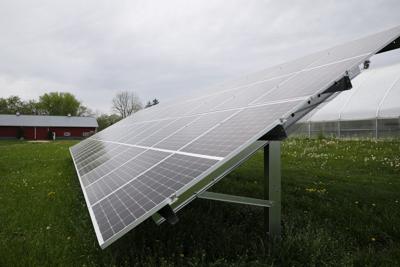Dane County will join an effort to block two of the Madison area’s largest utility companies from increasing electric and gas rates and changing solar programs, concerned their plans will undercut local clean-energy goals.
Many south-central Wisconsin residents already saw their utility bills go up at the beginning of the year after Madison Gas & Electric increased rates by about 9%, around $8.20 more per month. That might be just the start of a series of increases.
Wisconsin Power & Light, owned by the Alliant Energy Co., and Madison Gas & Electric both asked the state’s Public Service Commission in April for approval to increase their electric and natural gas rates throughout the county.
MGE requested a 3.75% electric rate increase in 2024 and a 3.41% increase in 2025; a typical residential customer would pay about $5 a month more in 2024 and 2025. For natural gas, the company requested a 2.56% rate increase in 2024 and a 1.66% increase in 2025, which will average to a $2.18 monthly increase in 2024 and $1.11 in 2025.
WPL’s proposed increases were even steeper. The utility applied for an electric rate increase of 8.4% next year and 5.4% in 2025, along with a natural gas increase of 6.3% in 2024.
That’s about $13 a month for the average residential electric customer’s bill in 2024 and $5.80 in 2025, according to WPL. The increase for natural gas would cost WPL customers an average of $5.30 a month in 2024 and the rate would be held flat in 2025.
The companies attributed the rate changes to accelerating the transition to renewable energy, creating more solar projects, grid modernization and inflation.
“MGE is growing our use of renewable energy, launching innovative programs and new technologies for a smarter, more dynamic and resilient grid that delivers greater efficiency and value for the benefit of all customers,” the company said in a written statement. “We continue to invest in this shared resource to ensure all customers benefit from new technologies and from cost-effective, carbon-free energy sources.”
Along with the rate increases would be changes in the way the utilities reimburse solar energy customers for the extra power they produce.
In addition to the rate increases for all customers, the changes would affect how much the utilities pay people with rooftop solar systems for the excess electrical power they generate. MGE says its new compensation rates would apply mostly to smaller, residential solar arrays and only for new participants as of next April.
Dane County seeks ‘a seat at the table’
Dane County joined other organizations to challenge the rate increases to ensure the county can meet its climate goals, said Kathy Kuntz, director of the county Office of Energy & Climate Change.
This year, Dane County achieved its goal of powering county facilities with 100% renewable electricity largely as a result of its solar project partnerships with MGE and WPL, county documents state. The county is the first in Wisconsin and the fourth in the U.S. to achieve that milestone.
Additionally, the county plans to reach carbon-neutral status by 2050, as laid out in the 2020 Dane County Climate Action Plan, with the intermediate goal of reducing greenhouse gas emissions 50% countywide by 2030. Both MGE and WPL were members of the Climate Action Council that approved those objectives.
Kuntz said the rate changes could put that all at risk, with the new rates equating to “substantial changes” to how the utility will compensate customers who install solar panels. The rate increases also would cost the county more money from its operating budget.
“These changes will affect the savings associated with an installation, which might make solar less viable for some households, local governments or businesses,” Kuntz said. “At present we don’t fully understand the savings implications because the proposed rates are quite complicated. That uncertainty is also likely to slow solar installations.”
The county’s request to intervene, which was overwhelmingly approved by the Dane County Board last Thursday, enables county leadership to participate in the rate case as it moves forward.
“It gives us a seat at the table,” Kuntz said. “Intervention does not require that we actively participate and it does not assert that we have a specific position — it just gives us the option to participate.”
The county joins a growing number of municipalities and groups who have also intervened in the rate change, including the cities of Madison and Middleton, University of Wisconsin-Madison, RENEW Wisconsin, Blacks for Political and Social Action of Dane County and the Solar Energy Industries Association.
While the 2021 federal Inflation Reduction Act incentivized moderate-income households, nonprofit groups, schools and local governments to pursue solar, Kuntz said the rate increases also raise issues of equity.
“These proposed utility changes might jeopardize that access to solar,” Kuntz said. “We would be concerned about any initiative that had the potential to slow the transition to clean energy given the urgency of our climate crisis.”
Dane County has more than 200 electric and gas meters, most of which would be affected by the rate increases, Kuntz said. However, the county has not yet calculated how much more taxpayer money the utility hikes would cost.
MGE and WPL’s proposals remain under regulatory review.






